Where to see Bernini’s art in Rome: a quick guide to seeing Bernini’s masterpieces in the Eternal City: Bernini churches, piazzas, chapels, fountains and museums. Updated December 2021.
The beauty of Rome as we see it now took shape over the course over two millennia by the hands of masters of the arts and architects from the ancient and less remote past.
However, out of the many names who contributed to the development of the Eternal City, there is one that left a mark without which Rome, as we see it now, would be unthinkable: that of architect Gian Lorenzo Bernini.
To give you an idea, consider this: St Peter’s Square, St Peter’s Basilica and Piazza Navona, just to name three of the most famous landmarks in Rome, all look the way they do thanks to the hand and vision of this incredible artist!
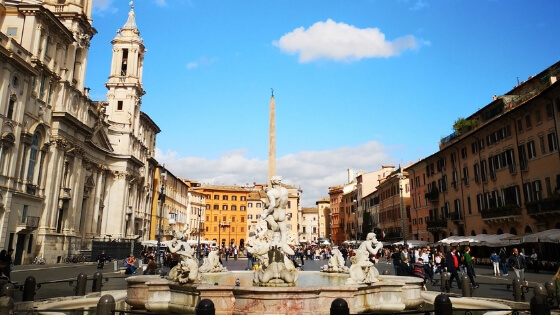
Stumbling upon Bernini’s masterpieces in Rome is easy and dare I say unavoidable (not that you want to avoid them anyway!).
However, it can be handy to have a shortlist of those that are most famous and easier to see.
This is what this article is: a non-exhaustive yet handpicked list of where to see the best of Bernini in Rome.
Please note: Sources for this article are the websites linked to from the body of the text, information from guided tours we have taken while in Rome and the book ‘La Roma di Bernini’ by F. Gizzi (in Italian)

Please note: this post contains affiliate links and, should you make a purchase through them, we might make a small commission.
What is special about Bernini’s art in Rome
Writing a proper bio of Gian Lorenzo Bernini would be beyond the scope of this post (you can have a look at a good one here).
However, there are a few facts about this artist that I believe can help understand why his work is not just beautiful but also special and unique to the city of Rome.
The thing about Bernini’s art in Rome is that while it is true that Rome wouldn’t be Rome without Bernini, it is also true that Bernini wouldn’t probably be Bernini without the city.
The relationship between the two is strong and mutual: Bernini took inspiration from the classics and thrived mostly under the Pontificate of the Barberini family and Rome served as both its Muse and recipient of his art.
The result is mesmerizing: the city and the artist came together to create a city that is unique in the world.
Gian Lorenzo Bernini: essential bio
Gian Lorenzo Bernini (1598-1680) is an architect and sculptor who worked and lived in Rome in the XVII century
Son of a sculptor, he started working with his father at a very young age but then rose to unprecedented glory in his own right, mostly thanks to the favor his art earned him with the Barberini family and in particular with Maffeo Barberini, who ruled over Rome as Pope Urban VIII for a large part of Bernini’s life.
Bernini is famous for his statues, fountains and architectural designs and is often regarded as one of the masters of Baroque art in Rome.
However, there is much more than Baroque in his art: hugely inspired by the classics, Bernini’s art mixes elements of classicism and more contemporary art moments like no one before, an element that makes his art stand out from that of many contemporaries.
Where to see Bernini’s work in Rome: piazze and fountains
One of the many things that make Bernini’s art in Rome special is the fact that his art is not just inside museums in the city.
Rather, his art is the city! Bernini was an architect as well as a sculptor and his hand shaped many of Romes’ external spaces that got their now-famous appearance thanks to Bernini’s visions.
These are some of the most impressive and easy to see.
Piazza Navona and the fountain of the 4 rivers
I open this list with one of the most famous squares in the whole of Rome, Piazza Navona, and one of Bernini’s most applauded and famous works of art: the fountain of the 4 rivers in its center.
The square and piazza are open to the public and easy to visit any time of the day.
My favorite time is early in the morning, before 10 am, the time when visitors and vendors start pouring into the square, or at night when clever lighting lights up the water of the fountain.

Despite being at the start of this list, Piazza Navona is actually a pretty late creation of Bernini and one that did not happen under Pope Urban VIII but rather under his successor, Pope Innocenzo X Pamphili.
The Pontificate of Pope Pamphili was a hard time for Bernini, too close his predecessor to be welcome to the new court.
The new pope gave preference to the work of Borromini, another master of that time, and Bernini felt suddenly excluded from the limelight that he had enjoyed for a long time under the Barberini patronage.
However, Bernini came up with a clever idea that allowed him to regain visibility and gave us Piazza Navona as we see it now.
When the Pope announces he wanted to build a monumental square and fountain in front of its palace, Bernini arranged to send the Pope and Donna Olimpia Maidalchini, the true power behind Pope Pamphili, a model of his idea, made of silver, as a present.
This present is said to have captured the heart of the recipient: Bernini got the commission for the square as we see it now.
Read here >>> our full guide to the making and the symbols of the Fountain of the Four Rivers.
Good to know: Piazza Navona has 3 fountains. While the Fountain of the Four Rivers is the one carrying most of Bernini’s artwork, his hand is also behind part of the Fountain of the Moor, also on the square.
- Address: Piazza Navona, the fountain of the 4 rivers is the biggest one in the center.
- How to get there: all bus routes serving Corso Vittorio or Torre Argentina, including 30, 60, 62, 81, 87.
- Admission: N/A This is a square, open to public access day and night
Piazza di Spagna and La Barcaccia
Piazza di Spagna is mostly famous for its impressive steps (the Spanish Steps) and the gorgeous church of Trinita de’ Monti at its top, however, it is also an important place for Bernini lovers and for more than one reason.
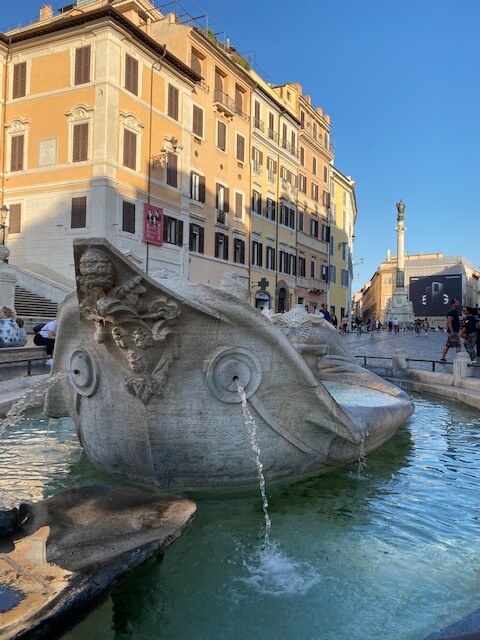
First and foremost, the square is interesting for a sculpture we can still enjoy, that of the ‘Barcaccia’.
The Barcaccia is one of the most famous fountains in Rome and sits at the very basis of the Spanish steps.
It is a beautiful, rather inconspicuous fountain, easily missed because of the crowds filling the square, but it is a work of art by the hand of not one but two Berninis: Bernini father and Gian Lorenzo, the son.
The fountain is built to resemble a sinking boat and wanted to remember the overflowing of the river Tiber in 1598, which apparently got a boat stranded in the location where the fountain now stands!
Fun fact: the shape of the boat is that of the typical vessels found on the river Tiber and still in use today (many are restaurants!). The choice of theme allowed the Berninis to make the most of the low pressure of water in this area, insufficient for a taller built but perfect for one only marginally raising from the ground!
The fountain was built under Pope Barberini, whose emblematic bees adorn the fountain.
Piazza di Spagna itself was not designed by Bernini but it is interesting to know that he did have a plan for it which, some say, may have inspired the final appearance of the steps, by De Sanctis.
You can find all the info on how to see La Barcaccia Fountain here.
- Address: Piazza di Spagna
- How to get there: Metro stop Spagna, bus 61, 80, 85, 160 and all buses serving Piazza San Silvestro
- Admission: N/A This is a square and therefore free to access day and night.
Fontana del Tritone
Bernini built several fountains in Rome and one of the most famous now sits at the center of busy Piazza Barberini, at the bottom of Via Veneto and the appropriately named Via del Tritone.

The fountain was built by Bernini under the patronage of Pope Urban VIII Barberini.
The fountain represents four dolphins holding a shell above which stands a triton, a theme that is typical of classical art but that Bernini uses to also pay homage to his Pope, whose bees decorate the statues.
- Address: via del Tritone
- How to get there: metro stop Barberini, buses including 61, 62, 80, 85, 160, MA10
- Admission: N/A. This is a public square and therefore accessible any time day and night. Nowadays, it is a busy roundabout, with cars and buses. Make sure you cross carefully and get close to the fountain to see its details: from afar, the square surrounding it drowns it in visual noise and truly does not give it any justice.
Read here >>> description + history of the Triton Fountain
Good to know: Piazza Barberini also hosts another fountain by Bernini, the Fountain of the Bees. This is now on the corner of the square and has the famous Barberini’s bees, the Barberini family crest.
Bernini’s elephant in Piazza della Minerva
One of the most peculiar and fun artworks by Bernini is the statue of the little elephant now gracing the center of Piazza della Minerva, just beside the Pantheon.
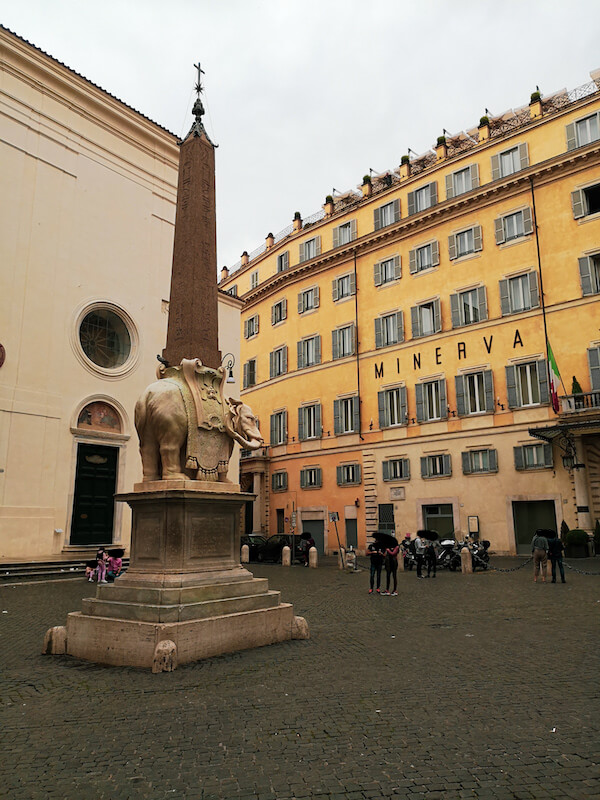
This is a peculiar sculpture, unique in Rome for the animal depicted and its look, and has a peculiar story, interesting also to understand the very peculiar environment that was Rome in the XVII century.
The statue represents a small elephant carrying an Egyptian obelisk and it sits in front of the headquarters of the Dominican order, overlooking the square.
Bernini designed it to represent the need for a strong mind as support to strong knowledge but the Rome gossip vine quickly took over the narrative about this statue which quickly got known as ‘Minerva’s piglet’ (Porcino di Minerva), due to the pig-like features of the small pachyderm!
You can read more about this story and the cute sculpture in Piazza della Minerva here
Good to know: on the same square, Bernini is also behind the burial monument to Venerabile Maria Raggi, in the church of Santa Maria Sopra Minerva.
- Address: Piazza della Minerva, to the right side of the Pantheon
- How to get there: several bus lines serve nearby Torre Argentina 30, 40, 62, 64, 81, 87 and 492 (no bus stops on the actual square)
- Admission: N/A, this is a public square and the elephant is in the center.
Ponte Sant’Angelo
The last two items on this part of the list are among the most impressive and beautiful of all Bernini’s opus and they need to be addressed together, as this is how Bernini had imagined them.
Ponte Sant’Angelo is the bridge connecting Rome City center with Vatican City and runs immediately under Castel Sant’Angelo, itself part of the Vatican at the time.
Bernini imagined this bridge as a monumental entry to the Pope’s city and it designed it to be overlooked by statues of angels with vests moved by a wind that is bost terrestrial, form the river, and divine.
The angels represent a Via Crucis of sort and are imposing and wonderful. However, the ones we see now on the bridge are not by Bernini himself but rather by his disciples, based on the drawings of Bernini: Bernini himself sculpted two of them, now preserved and visible in the church of Sant’Andrea delle Fratte (see also below).
- Address: Ponte Sant’Angelo
- How to get there: among the closes bus stops there are lines 62, 23, 271, 982
- Admission: N/A this is a public bridge

Piazza San Pietro and its colonnade
The vision Bernini had for the Vatican didn’t stop at its entrance via Ponte Sant’Angelo but extended to the piazza in front of St Peter’s Basilica, one of the most impressive in the world and a creation of his genius.
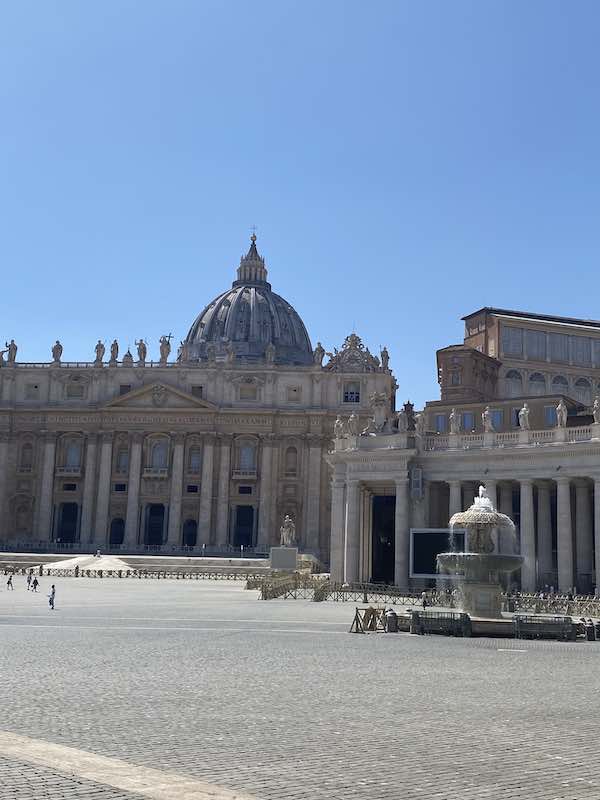
At the time (and until the first decades of the XX century, when Via della Conciliazione was built), the area around St Peter Basilica was a busy, non-monumental area with small alleys and streets that hid the marvel that is the Basilica to then surprise the unsuspecting visitors with its unexpected grandeur and magnificence.
Bernini took on the job to make the square in front of St Peter as spectacular and grand as it could be and, truly, he did: his vision is at the basis of the square that is now in front of the Basilica and the two large colonnades that seem to embrace the visitors and drive the eye towards the center of Christianity.
The square is stunning and a product of Bernini’s vision in more ways than meet the eye of the casual visitor. One of its secrets is in the colonnade itself.
Bernini was fond of the use of ‘forced perspective’ an architectural technique that tricks the eye into seeing something (movement, depth) not necessarily there and applied it to its colonnade.
It is fun to spot: as you walk into the square, look at the colonnade and take a mental note of the number of rows of columns you see.
Then, spot the markings on the ground, step on one of them and look at the columns again: many will disappear and you will believe you are in front of a single columns row!
It is an incredible thing with spot and one I always recommend to show to children if you are visiting the Vatican with kids but it is very impressive for adults too – don’t miss it! You can find all the info to visit St Peter’s Square and what makes it special here.
- Where it is: Piazza San Pietro
- How to get there: Metro Ottaviano-San Pietro, several bus lines including 40 , 64, 62, 19 (tram), 49, 32, 982, 492, 990, 81
- Admission: N/A There is no admission to Piazza San Pietro nor you need a passport to enter the square, despite it being in the independent Vatican State. If visiting the Vatican however, I recommend you look at our Vatican guide, which has important info on the dress code for the Basilica and museums and practical tips for visitors.
Where to see Bernini in Rome: churches and chapels
Bernini worked on many of Rome churches, both outside and inside. The ones below are some of the most impressive and among the easiest to visit even during a short visit to Rome.
St Peter’s basilica
There is so much to say about St peter’s Basilica and Bernini that even writing a short paragraph to introduce it feels overwhelming so I will just say this: Bernini was one of the main architects giving the Basilica the incredible interior and appearance that we see now and no trip to Bernini’s Rome would be complete without at least a long stop in this masterpiece.
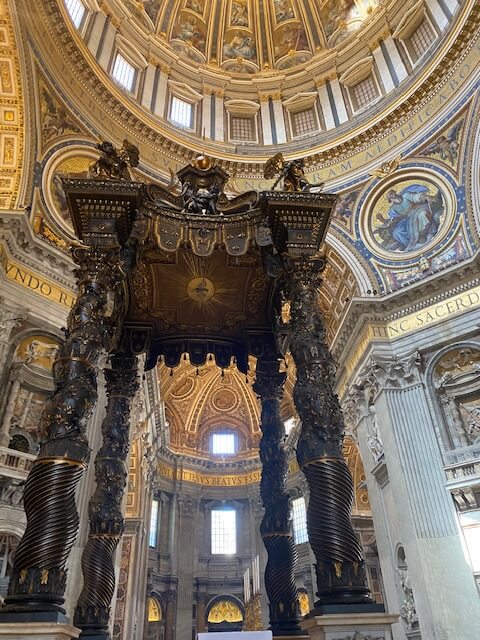
The best way to learn about Bernini’s work in St Peter’s basilica is to get an art-led tour or even just an audio guide and take it the masterpieces in your own time
Among the many, you will want to notice the low steps at the Basilica’s entrance, the main nave, the cupola and pillars and of course the colossal Baldacchino, one of Bernini’s most famous and admires pieces. You can find all the info you need to plan a visit to St Peter’s Basilica here.
- Address: Piazza San Pietro, Vatican City
- How to get there: several bus lines including 40 , 64, 62, 19 (tram), 49, 32, 982, 492, 990, 81
- Opening hours: 7 am – 6.30 pm (1 Nov to 31 March); 7 am – 7 pm (1 April – 31 October). Official info here
- Admission: admission to the basilica is free. Please be aware that the basilica enforces a strict dress code for men and women. Security checks at the entrance often cause long lines. Skip the line options and tours are available here
Cornaro Chapel in Santa Maria della Vittoria and the ecstasis of St Therese
One of the most beautiful and famous works by Bernini is the Cornaro Chapel, a small yet impressive side chapel in the church of Santa Maria della Vittoria, in Rome city center.
The chapel is famous for the incredible statue called ‘the ecstasis of St Therese’ or ‘the Transverberation of Saint Teresa‘ in which the Saint is represented in a state of religious abandonment while transfixed by the love of God in a form of an angel.
The statue is a masterpiece and has attracted a lot of attention for many reasons including a strongly perceived sensuality and even eroticism of the representation.
Due to its uniqueness and evocative power, this sculpture is now considered one of the best statues in Rome and a must see for art lovers.
- Address: Via XX Settembre 17
- How to get there: Metro Repubblica or Barberini, buses 60, 62, 492, Termini station is also nearby
- Admission: free, although at times a small collection is requested on entry. Careful with the peculiar opening hours here
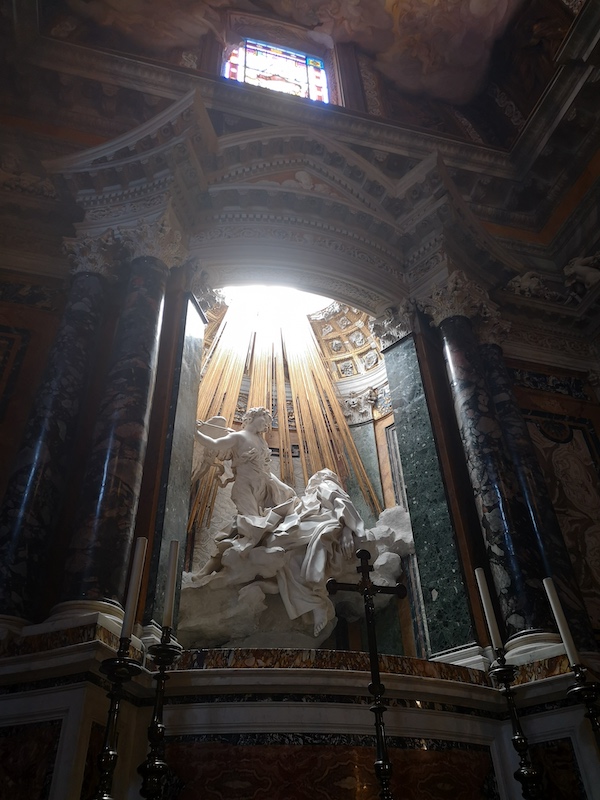
San Andrea delle Fratte
The Church os Sant’Andrea delle Fratte enters the list of must-see places in Rome for Bernini lovers as it is the church now hosting the two angels Bernini created for Ponte Sant’Angelo.
The angels are sculpted in marble and, as mentioned above, were the only two Bernini sculpted himself. His hand is the very reason why the angels didn’t make it onto the actual bridge and were instead replaced with copies.
Pope Clemens IX didn’t want them to get damage and kept them in Palazzo Bernini until they were donated to the church in 1729
- Address: Via di Sant’Andrea delle Fratte
- How to get there: 71, 92, 71, 83, 85
- Admission: free, official site with opening hours here
Santa Maria del Popolo
Santa Maria del Popolo is one of the so-called twin churches overlooking Piazza del Popolo, ‘so-called’ twin as in reality much more different from each other than a first look may suggest.
One of the two churches, in particular, was redone by Bernini under pope Alexander VII, Santa Maria del Popolo, which has several works of art by Bernini especially in the incredible Chigi Chapel.
- Address: Piazza del Popolo
- How to get there: metro Flaminio, all the buses serving Piazzale Flaminio (transport hub for Piazza del Popolo)
- Admission: free. opening hours
Good to know: Piazza del Popolo has an additional work by Bernini, the inside of Porta del Popolo, the big gate to the city, done up by Bernini in the occasion of the visit of Queen Christine of Sweden in 1655.
Sant’Andrea al Quirinale
If you love Bernini, chances are you have your own favorite creation by the Master and so did he.
According to Bernini himself, his best work was the church Sant’Andrea al Quirinale, a church that, according to the memoir of Benigni’s son, an elderly Bernini asked to visit over and over again so he could admire the play of light on the marbles and gold detailing of the church.
- Address: Via del Quirinale
- How to get there: 61, 71, 170, 590, H
- Admission: free, official site with opening hours here
Good to know: very close to Sant’Andrea al Quirinale sits the Quirinale Palace, itself partially designed by Bernini. You can see his hand in the small loggia above the Quirinale main entrance.
Where to see Bernini’s art in Rome museums: the Borghese Gallery and Palazzo Barberini
In the paragraphs above, I focused on the outside space and churches that hold Bernini’s art, however, no trip to Bernini’s Rome would be complete without a visit to some of his most amazing sculptures not hosted in museums around the city.
The main museum to visit to admire his work is the famous Borghese Gallery.
Located inside the vast and beautiful Villa Borghese (now a public park), the Gallery has some of the most famous statues in Rome, including several by Bernini.
Among the most famous are the classical themed ‘Aeneas, Anchises and Ascanius’, ‘The Taking of Proserpina’, ‘Apollo and Daphne’ and the David.
Find my guide to the Borghese Gallery here.
Interesting to know. Looking at these statues, you may notice that many if not all of them have a position of the body that is slightly twisted, as to resemble a spiral. This was intentional: this characteristic forces the onlooker to move around the statue and take it in from more than one angle to see it all. This forces additional attention and a better, more personal engagement with the work of art.
- Address: Piazzale Scipione Borghese 5, inside Villa Borghese, on the Parioli side of the Park
- How to get there: buses 53, 63, 83, 92, 910
Admission: booking mandatory. You can select and book a timeslot from the official Gallery website here or you can bok skip the line tours here
Another important Bernini landmark in Rome is Palazzo Barberini.
Palazzo Barberini, as the name suggests, is th elegant palace that used to be residence to the Barberini family from the XVII century onwards.
The palace is now part of the National Museum of Ancient Art and it has been partially designed by Bernini himself.
The palace is worth adding to a Bernini itinerary in Rome for its appearance and the importance the Barberini family had in commissioning and financing so many of Bernini’s interventions in Rome.
You can read here >>> our guide to Barberini Palace in Rome.
I hope you enjoyed this short list of artwork by Bernini you can easily see in Rome and it gave you some ideas for things to add to your Rome itinerary. Safe travels to Rome!
